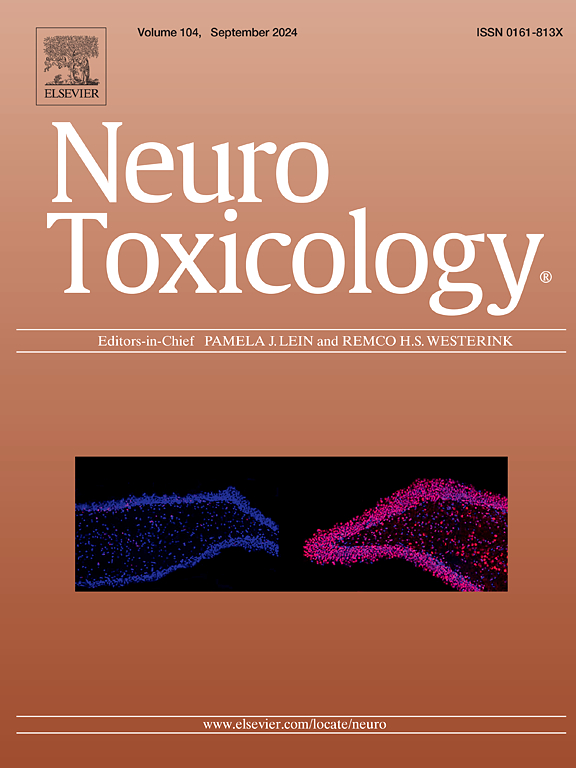产前低剂量毒死蜱对C57BL/6J小鼠神经行为和代谢的影响。
IF 3.9
3区 医学
Q2 NEUROSCIENCES
引用次数: 0
摘要
毒死蜱是一种有机磷杀虫剂,已知在发育早期接触后会产生严重的神经毒性。到目前为止,很少有数据描述低剂量暴露的神经行为和代谢后果,接近产生胆碱酯酶抑制的阈值。当前研究的目的是描述产前暴露于低剂量毒死蜱(0.5mg/kg/天)的影响,并比较观察到的神经行为和代谢变化与明确的日剂量5mg/kg。从妊娠第6.5-17.5天,C57BL/6J孕鼠分别暴露于0、0.5或5mg/kg/天毒死蜱。在暴露结束时测定了母鼠和幼崽的代谢谱,并分析了后代在青春期晚期和成年早期的行为。暴露于5mg/kg毒死蜱会破坏与氧化应激反应和大脑内能量代谢相关的代谢物,并对后代的自发行为和学习产生长期损害。暴露于较低剂量的0.5mg/kg/天降低了鸟氨酸下游代谢物的水平,暴露于5mg/kg/天也会破坏这一过程。此外,0.5mg/kg/天毒死蜱会损害后代成年后的自发行为,但对学习或逆转没有明显影响。这些发现支持了一个结论,即产前低剂量毒死蜱暴露会产生长期的代谢和神经行为障碍,类似于高剂量暴露所见的缺陷。本文章由计算机程序翻译,如有差异,请以英文原文为准。
Neurobehavioral and metabolic effects of prenatal low-dose chlorpyrifos in C57BL/6J mice
Chlorpyrifos is an organophosphorus insecticide known to produce severe neurotoxicity following early developmental exposure. So far, little data describes the neurobehavioral and metabolic consequences of low-dose exposures, near the threshold to produce cholinesterase inhibition. The purpose of the current study was to characterize the impact of prenatal exposure to a low dose of chlorpyrifos, at 0.5 mg/kg/day, and compare observed neurobehavioral and metabolic changes to a well-defined daily dose of 5 mg/kg. Pregnant C57BL/6 J dams were exposed to either 0, 0.5, or 5 mg/kg/day chlorpyrifos from gestation day 6.5–17.5. A metabolic profile was determined in dams and pups at the end of exposure and behavior was analyzed in offspring during late adolescence and early adulthood. Exposure to 5 mg/kg chlorpyrifos disrupted metabolites associated with the oxidative stress response and with energy metabolism within the brain and produced long-term impairment in spontaneous behavior and learning in offspring. Exposure to the lower dose of 0.5 mg/kg/day reduced levels of metabolites downstream of ornithine, a process that was also disrupted with exposure to 5 mg/kg/day. Further, 0.5 mg/kg/day chlorpyrifos impaired spontaneous behavior in offspring during adulthood, though no significant effects on learning or reversal were seen. These findings support a conclusion that prenatal low dose chlorpyrifos exposure produces long-term metabolic and neurobehavioral impairment that resemble deficits seen with high dose exposure.
求助全文
通过发布文献求助,成功后即可免费获取论文全文。
去求助
来源期刊

Neurotoxicology
医学-毒理学
CiteScore
6.80
自引率
5.90%
发文量
161
审稿时长
70 days
期刊介绍:
NeuroToxicology specializes in publishing the best peer-reviewed original research papers dealing with the effects of toxic substances on the nervous system of humans and experimental animals of all ages. The Journal emphasizes papers dealing with the neurotoxic effects of environmentally significant chemical hazards, manufactured drugs and naturally occurring compounds.
 求助内容:
求助内容: 应助结果提醒方式:
应助结果提醒方式:


